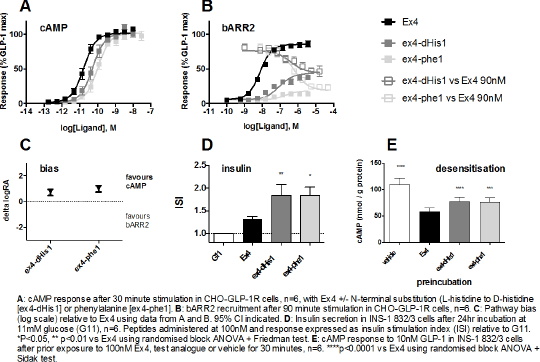Improving GLP-1 receptor biological activity in pancreatic beta cells via biased agonism Exendin-4 (Ex4) is a glucagon-like peptide-1 (GLP-1) mimetic used in the treatment of type 2 diabetes. Binding of Ex4 to the GLP-1R results in recruitment of both G proteins and β-arrestins, which have been implicated in signalling to divergent downstream biological events including potentiation of insulin secretion and reduction in β-cell apoptosis. We therefore sought to develop peptide analogues of Ex4 with bias between G protein and arrestin signalling, which might possess therapeutically useful characteristics. Analogue-induced β-arrestin-2 (βARR2) recruitment and cyclic AMP (cAMP) generation were tested in Pathhunter CHO-GLP-1R cells and these data used to calculate pathway-specific relative activities for each agonist (1). N-terminal substitutions to Ex4 led to 8-10-fold bias towards cAMP and away from βARR2 recruitment. Despite also exhibiting reduced potency for cAMP, test analogues were approximately twice as insulinotropic as Ex4 when administered to β-cells over 24 hours. This was associated with a 30% reduction in GLP-1R desensitisation in comparison to Ex4. These findings are in keeping with the canonical role of arrestins in mediating receptor desensitisation, and may have implications for development of GLP-1R mimetics with improved long-term efficacy.
1) Stahl et al. (2015). Mol Pharmacol. 87:866–77.
|


